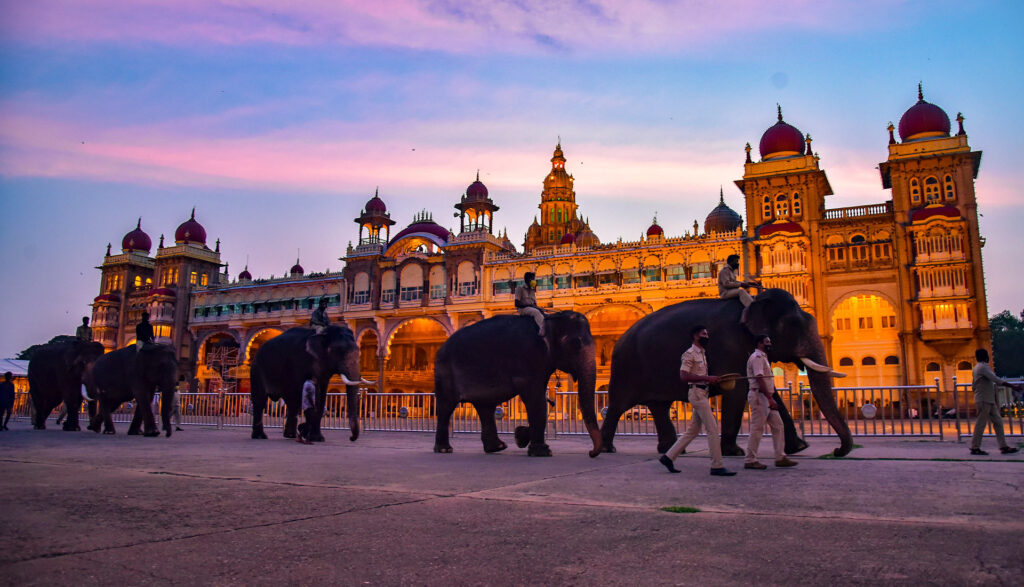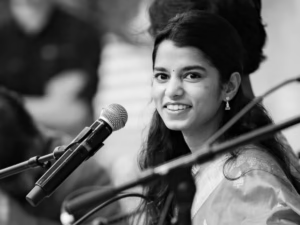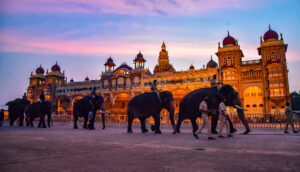Introduction
Mysuru Dasara is one of India’s most spectacular cultural festivals, celebrated annually in the historic city of Mysuru, Karnataka. Known as the “Royal Festival of Karnataka,” it is more than just a religious observance; it is a grand display of heritage, art, and tradition. The ten-day festival commemorates the victory of good over evil and holds a special place in the hearts of locals and visitors alike. From majestic palace illuminations to elephant processions and classical performances, Mysuru Dasara perfectly blends devotion, culture, and royalty.

Historical Background of Mysuru Dasara
The roots of Mysuru Dasara can be traced back over four centuries to the reign of the Wodeyar dynasty, which ruled the Kingdom of Mysore from the 14th century until the mid-20th century. While the festival of Navaratri is celebrated across India, the Wodeyars elevated Mysuru Dasara into a royal spectacle, turning it into a symbol of power, prestige, and cultural patronage.
Historically, the Wodeyars were devoted followers of Goddess Chamundeshwari, a form of Goddess Durga, and they considered the festival an opportunity to honor her divine victory over the demon Mahishasura. The Chamundi Hills, which rise majestically above Mysuru, became the focal point of Dasara celebrations. The Chamundeshwari Temple atop these hills, believed to date back to the 12th century, became central to the religious observances of the festival.
Over time, Mysuru Dasara became a reflection of the city’s prosperity, artistic excellence, and royal grandeur. The Wodeyars organized state-sponsored performances, exhibitions, and processions, blending religious devotion with cultural celebration, a tradition that continues today.
Mythological Significance
Mysuru Dasara is deeply rooted in Hindu mythology. It is said that the demon Mahishasura, who could change form at will, terrorized the heavens and the earth. The gods, unable to defeat him, created Goddess Chamundeshwari, an embodiment of divine power, to vanquish him. After nine days of fierce battle, the goddess defeated Mahishasura on the tenth day, known as Vijayadashami, symbolizing the triumph of good over evil.
This mythological connection is why Mysuru Dasara is so closely associated with the Chamundeshwari Temple and the royal family. The golden howdah procession, in which the deity’s idol is paraded on an elephant, is a reenactment of the goddess’s victorious journey, blessing her devotees and reaffirming faith in divine justice.
Royal Traditions and the Wodeyar Legacy
The Wodeyars were not only rulers but patrons of art, music, and culture. They used Dasara as an occasion to showcase their wealth, artistic tastes, and devotion. During their reign, Mysuru Dasara became a grand affair, featuring:
- Palace Illumination: The Mysore Palace is illuminated with thousands of bulbs, creating a magical spectacle at night. This tradition started in the early 20th century and continues to draw thousands of visitors each evening.
- Jumbo Savari (Elephant Procession): A majestic procession where the deity is placed atop a decorated elephant and paraded through the streets, accompanied by music, dancers, and cultural troupes.
- Torchlight Parade: A ceremonial parade featuring military bands and performers, symbolizing royal authority and discipline.
- State Awards and Honors: Historically, the Wodeyars used the festival to honor citizens, warriors, and artists, reinforcing the link between royalty and public life.
Even after the end of the Wodeyar rule in 1950, the traditions of Mysuru Dasara were maintained by the royal family and supported by the state government, ensuring continuity of the festival’s regal splendor.

Rituals and Religious Observances
Mysuru Dasara is more than a cultural event; it is deeply religious. Devotees visit the Chamundeshwari Temple and other local temples to offer prayers, participate in rituals, and seek blessings. Key religious observances include:
- Navaratri Puja: Devotees worship the goddess for nine nights, each night representing a different form of Durga.
- Ayudha Puja: On the ninth day, people worship tools, instruments, and vehicles, symbolizing gratitude for the means of livelihood.
- Vijayadashami: The tenth day marks the culmination of the festival, with the grand procession of the deity and public celebrations.
These rituals are accompanied by traditional music, chanting, and devotional songs, creating an atmosphere of spiritual fervor and communal participation.
Cultural Programs and Artistic Showcases
Mysuru Dasara is also a platform for showcasing Karnataka’s cultural richness. The festival features:
- Folk Dances and Music: Traditional performances like Dollu Kunitha, Veeragase, and Yakshagana enliven the streets, displaying the state’s folk heritage.
- Classical Arts: Music and dance recitals in classical styles like Bharatanatyam, Carnatic music, and Harikatha storytelling celebrate the spiritual and artistic traditions of Karnataka.
- Exhibitions and Fairs: Local artisans exhibit handicrafts, jewelry, textiles, and traditional cuisine, highlighting Mysuru’s craftsmanship and culinary heritage.
- Sports and Competitions: Events like traditional wrestling, horse riding, and archery contests are organized, preserving age-old traditions.
These programs make Mysuru Dasara a cultural extravaganza, attracting artists and enthusiasts from across India and abroad.
Tourism and Economic Impact
Mysuru Dasara has become a major tourist attraction, contributing significantly to the local economy. The festival draws thousands of visitors every year, leading to increased activity in the hospitality, transportation, and retail sectors. Local businesses, especially handicraft sellers and food vendors, see a surge in sales during the festival season.
Tourism during Dasara also encourages cultural exchange, as visitors from different parts of India and the world experience Karnataka’s traditions, cuisine, and lifestyle. Government initiatives to promote Dasara tourism include:
- Special tour packages and guided tours of Mysuru Palace and Chamundi Hills.
- Cultural workshops and demonstrations for tourists.
- Collaborations with travel agencies and media coverage to reach a global audience.
Modern-Day Celebrations
While rooted in tradition, Mysuru Dasara has adapted to modern times. Innovations include:
- Digital promotions to attract a global audience.
- Eco-friendly initiatives, such as reducing plastic use and managing crowd safety.
- Enhanced security and infrastructure, ensuring safe and smooth celebrations for thousands of attendees.
Despite modernization, the festival retains its authentic charm, with the royal procession, palace lighting, and religious rituals continuing as they have for centuries.
The Symbolism of Mysuru Dasara
Mysuru Dasara represents more than festivities—it symbolizes unity, culture, and devotion. It is a reminder of the region’s history, the power of good over evil, and the enduring legacy of the Wodeyar dynasty. The festival also reflects the harmonious blend of religion, art, and governance, making it unique among India’s many cultural celebrations.
Conclusion
Mysuru Dasara is a living tradition that has successfully blended history, culture, devotion, and tourism into a spectacular ten-day celebration. From its mythological roots to royal customs and modern-day festivities, the festival embodies the spirit of Karnataka. For anyone seeking to experience India’s cultural heritage, Mysuru Dasara offers an unforgettable journey through history, art, and spirituality.
Whether it is witnessing the illuminated Mysore Palace, enjoying the grand elephant procession, or immersing oneself in folk dances and classical music, Mysuru Dasara remains a testament to Karnataka’s rich and vibrant legacy—a festival where the past and present come alive in celebration.







More Stories
Maithili Thakur: From Folk Singing Sensation to Rising Political Star
Blood Moon Over Sydney: Unveiling the Celestial Show with Telephoto Magic
Global Data Centres 2025: Who’s Spending What -and Why It Matters